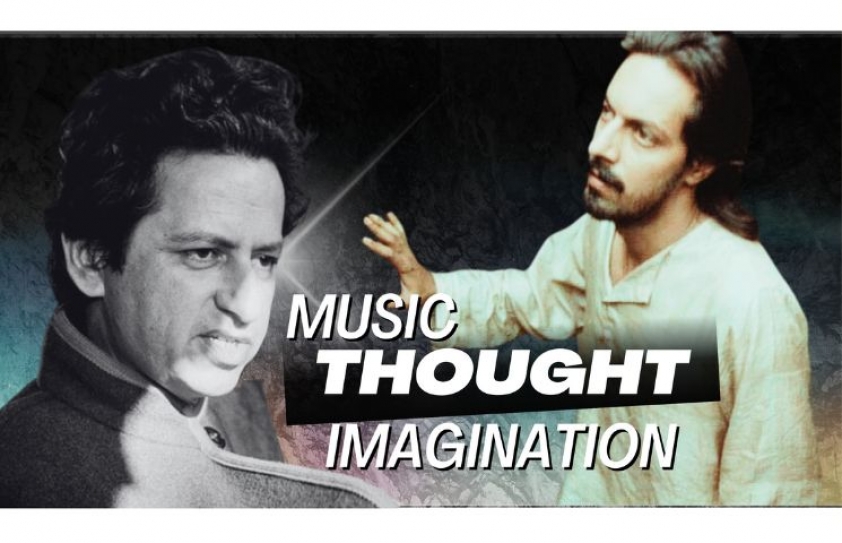
ALTERNATIVE ENTERTAINMENT: MUSIC OF THOUGHT AND IMAGINATION
by O.P. Srivastava February 18 2024, 12:00 am Estimated Reading Time: 4 mins, 43 secsIt is Kumar Shahani's Khayal Gatha (The Saga of Khayal), a 1989 Indian experimental film written and directed by Kumar Shahani, that O.P. Srivastava narrates today.
The film traces the history of the ‘khayal’ genre and its relationship with Indian classical dance.
Khayal is a form of Indian classical music developed in the 18th century. It was adapted from dhrupad, mobilizing elements of other classical and folk literature and music.
Khayal Gatha is a 103-minute film shot by KK Mahajan, starring Rajat Kapoor, Mangal Dhillon and Mita Vashisht. Kamal Swaroop and Ashmaki Acharya wrote the dialogues for the film. The film was financed by the NFDC and presented by the Madhya Pradesh Film Development Corporation. This was actor Rajat Kapoor’s debut film; he had graduated from FTII with a specialisation in direction. The film also featured Pandit Birju Maharaj and Alaknanda Samarth.
Khayal Gatha was the first of Shahani’s films to receive international accolades. The film was appreciated at the Rotterdam International Film Festival, where it was screened in the competition section. The film also received Best Film (Critics) Award at the 1990 Filmfare Awards.
The film is considered an important documentation of the tradition of Indian classical singing. ‘Khayal’ literally means ‘thought’ or ‘imagination’ in Hindi-Urdu and is based on improvising and expressing emotion. A ‘khayal’ is a verse of two to eight lines set to music. The lyric is an emotional account, possibly derived from poetic observation. The importance of the khayal’s content is for the singer to depict, through music in the set raga and the emotional significance of the content. The singer improvises and finds inspiration within the raga to depict the khayal.
The origin of khayal is controversial, although it is accepted that this style was based on dhrupad and influenced by Persian music. Many believe that Amir Khusro created the khayal style in the late 16th century, and Mughal Emperor Mohammad Shah popularized it through his court musicians.
Consider ‘Peer na jaani re balama, niki tihari anokhi preet’, a khayal in raga Malkauns in taal Tilwada. What does it convey? The lover does not understand the pangs of love – he loves me, no doubt, but what a strange way of loving! There is no frustration, but a sorrowful anguish, the desire to be with the lover. This type of khayal was conceived by Sadarang and Adarang, two players of the ‘been’ in Mohammad Shah Rangila’s court. An interesting anecdote has it that there once was a conflict between the dhrupad singers and the ‘been’ players in the court, giving the ‘been’ players an impetus to seek a new form of singing that would move away from the rigid, mathematical structure of the dhrupad. Some interaction between all the prevalent musical forms seems to have given rise to the khayal: it has the directness of expression and content-directed voice modulations of folk songs, the sensuousness and emotiveness of the ghazal and thumri, the intricate taan patterns of sufi qawwali, the bol-taans of dhrupad, the curves of the nam-twam and the resonant soundwaves of the ‘been’.
The film is presented in an abstract format. A music student (Rajat Kapoor) listens to stories and legends about the birth and evolution of the khayal form of classical Indian singing. Actors, who play figures associated with the history of classical music, enact these stories.
The film interlaces the history of khayal with several legends associated with it, like those of Rani Rupmati and Baaz Bahadur, Heer and Ranjha, and Nala and Damyanti. The legends are then worked into some of the key figurations determining the khayal narrative, focussed on Nayika, the object of the address, and Sakhi, her companion.
The result is a visually stunning narration condensing legend, history and poetry, and emphasizing hybridity in all cultural practices. Some of the foremost musicians from the Gwalior gharana (the oldest of the several that exist), including Krishnarao Shankar Pandit, Sharatchandra Arolkar, Jal Balaporia and Neel Bhagwat, made key musical contributions to this work. Shahani also used the dance of Birju Maharaj, India’s best Kathak dancer, in the narrative.
17.jpg)
For Shahani, the crucial relevance of this music to cinema resides in its theory of shruti, the subdivisions between given notes in a raga that eventually yield a continuous scale. In khayal, musical elaboration could be based on improvisation by emphasizing sequence rather than discrete notes or the rhythmic cycle so that, like jazz or other musical forms emerging from oppression, it can resist all efforts at encoding while remaining free to assimilate a spectrum of musical elements from as far as Central Asia, Turkey and Persia.
Khayal Gatha juxtaposes historical and contemporary legends about khayal to emphasize shrutis as approximates, which are never absolute. Shahani uses a technique of cinematic expression in which ‘forms’ are not simply reproduced but induced by movement, built by colour and infused with sound.
We hear a number of ragas in the film: first Yaman Kalyan, then Hameer, Bhop, Gaud Malhar, Megh, Sarang, Bageshari, Malkauns, Bihag, Kafi, Miyan Ki Malhar and, finally, Bhairavi.
The colour patterns transition visually from brown to red, then white, purple, blue, red, orange, purple, yellow, blue and, finally, red. Every colour is presented in a variety of hues. They arrive and move across the screen in a carefully controlled choreography. These colours have no direct connection to the ragas and bandishes presented. What they do have in common, however, is that they are the introduction to evocation, and evocation is the core of khayal.




-173X130.jpg)
-173X130.jpg)
-173X130.jpg)
-173X130.jpg)
-173X130.jpg)
-173X130.jpg)
-173X130.jpg)
-173X130.jpg)